Urban Flood Risk Assessment Based on Dynamic Population Distribution and Fuzzy Comprehensive Evaluation
Abstract
1. Introduction
2. Study Area and Data Description
2.1. Study Area
2.2. Data Description
- Maximum 1-day rainfall amount (Rx1day, mm). Precipitation is a direct factor leading to urban flooding. Rx1day reflects the extreme precipitation leading to floods in the study area. The Rx1day index was calculated according to daily precipitation data recorded at observational stations during 1986–2019. The data were obtained from Shenzhen hydrological data almanacs and the University of Hong Kong.
- Number of heavy rainfall days above 50 mm (R50 mm, number/year). R50 mm reflects the frequency of extreme precipitation. The length and source of the data series were consistent with those of Rx1day.
- Digital elevation model (DEM, m). This index reflects the topographical conditions of the study area. Areas at low elevation are generally more prone to flooding because rainfall flows from areas of high elevation to areas of low elevation under natural conditions. The DEM data were accessed from the Geospatial Data Cloud (https://www.gscloud.cn/, accessed on 20 May 2020).
- Slope (SL, degree). This index is used to reflect the degree of topographic change. Mountain areas generally have severe slopes that prevent water collection, whereas lowlands or flatlands have gentle slopes that result in a constant threat of flooding. The index was calculated from the DEM using GIS techniques.
- Land use pattern (LUP). Runoff conditions vary considerably under different patterns of land use. A runoff coefficient was used to differentiate the LUP. Seven patterns were selected and assigned different runoff coefficients according to the Code for the Design of Building Water Supply and Drainage of China (GB50015-2003) and the Code for the Design of Outdoor Wastewater Engineering of China (GB50014-2006). The runoff coefficient of forest land, herbaceous land, wet land, crop land, bare area, built-up area, and water bodies was set as 0.15, 0.2, 0.5, 0.6, 0.7, 0.9, and 1, respectively. The land use data were accessed from the European Space Agency (https://viewer.esa-worldcover.org/worldcover, accessed on 20 May 2020).
- Distance to the river (DR, km). Regions near rivers might be prone to flooding because of dyke breaching or overtopping. Conversely, regions far away from rivers are generally safer. The DR index was set to 0 at the river and its value increased as the distance to the river increased. This step was conducted using Euclidean distance in the GIS.
- Gross domestic product density (GDP, yuan/km2). This index is important for reflecting the economic situation and the level of social development of the study area in 2019. The data were derived from a geographic remote sensing ecological network.
- Dynamic population (D-POP, people/km2). Population distribution is crucial regarding the accuracy of the results of urban flood risk assessment. In this study, D-POP reflected the dynamic change of population within the study area. The data were accessed based on location information clustering of Baidu products (e.g., web search, maps, weather, and music) accessed by smartphones.
- Building density (BD). The index refers to the ratio of the building area in each grid to the total grid area within the study area. The data were accessed from BIGMAP.
- Pipe network density (PD, km/km2). The index refers to the length of the drainage pipe network in each grid, which reflects the capability of urban flood control and disaster reduction to a certain extent. The drainage pipe network data were provided by the China Institute of Water Resources and Hydropower Research.
3. Method
3.1. Calculation of the Weights for the Indexes
3.1.1. Analytic Hierarchy Process (AHP)
3.1.2. Entropy Weight (EW)
3.1.3. Combined Weights
3.2. Fuzzy Comprehensive Evaluation
3.3. Determination of Flood Risk Level
4. Results and Discussion
4.1. Quantification of the Indexes
4.2. Dynamic Population Analysis
4.3. Calculation of the Weights
4.4. Urban Flood Risk Assessment
5. Conclusions
Author Contributions
Funding
Institutional Review Board Statement
Informed Consent Statement
Data Availability Statement
Conflicts of Interest
References
- Stefanidis, S.; Stathis, D. Assessment of flood hazard based on natural and anthropogenic factors using analytic hierarchy process (AHP). Nat. Hazards 2013, 68, 569–585. [Google Scholar] [CrossRef]
- Woodruff, J.D.; Irish, J.L.; Camargo, S.J. Coastal flooding by tropical cyclones and sealevel rise. Nature 2013, 504, 44–52. [Google Scholar] [CrossRef]
- Zheng, F.; Westra, S.; Leonard, M.; Sisson, S.A. Modeling dependence between extreme rainfall and storm surge to estimate coastal flooding risk. Water Resour. Res. 2014, 50, 2050–2071. [Google Scholar] [CrossRef]
- Xu, H.; Ma, C.; Lian, J.; Xu, K.; Chaima, E. Urban flooding risk assessment based on an integrated k-means cluster algorithm and improved entropy weight method in the region of Haikou, China. J. Hydrol. 2018, 563, 975–986. [Google Scholar] [CrossRef]
- UNDRR and CRED. The Human Cost of Disasters: An Overview of the Last 20 Years (2000–2019). 2020. Available online: https://www.undrr.org/publication/human-cost-disasters-overview-last-20-years-2000-2019 (accessed on 18 December 2021).
- Wilby, R.L.; Beven, K.J.; Reynard, N.S. Climate change and fluvial flood risk in the UK: More of the same? Hydrol. Process. 2008, 22, 2511–2523. [Google Scholar] [CrossRef]
- Du, S.; Anton, V.R.; Shi, P.; Wang, J. A dual effect of urban expansion on flood risk in the Pearl River Delta (China) revealed by land-use scenarios and direct runoff simulation. Nat. Hazards 2015, 77, 111–128. [Google Scholar] [CrossRef]
- Zou, Q.; Zhou, J.; Zhou, C.; Song, L.; Guo, J. Comprehensive flood risk assessment based on set pair analysis-variable fuzzy sets model and fuzzy AHP. Stoch. Environ. Res. Risk Assess. 2013, 27, 525–546. [Google Scholar] [CrossRef]
- Wang, Z.; Lai, C.; Chen, X.; Yang, B.; Zhao, S.; Bai, X. Flood hazard risk assessment model based on random forest. J. Hydrol. 2015, 527, 1130–1141. [Google Scholar] [CrossRef]
- Lai, C.; Chen, X.; Chen, X.; Wang, Z.; Wu, X.; Zhao, S. A fuzzy comprehensive evaluation model for flood risk based on the combination weight of game theory. Nat. Hazards 2015, 77, 1243–1259. [Google Scholar] [CrossRef]
- Sperotto, A.; Torresan, S.; Gallina, V.; Coppola, E.; Crittoa, A.; Marcomini, A. A multi-disciplinary approach to evaluate pluvial floods risk under changing climate: The case study of the municipality of Venice (Italy). Sci. Total Environ. 2016, 562, 1031–1043. [Google Scholar] [CrossRef]
- Xu, H.; Xu, K.; Wang, T.; Xue, W. Investigating Flood Risks of Rainfall and Storm Tides Affected by the Parameter Estimation Coupling Bivariate Statistics and Hydrodynamic Models in the Coastal City. Int. J. Environ. Res. Public Health 2022, 19, 12592. [Google Scholar] [CrossRef] [PubMed]
- Benito, G.; Lang, M.; Barriendos, M.; Llasat, M.; Frances, F.; Ouarda, T.; Thorndycraft, V.R.; Enzel, Y.; Bardossy, A.; Coeur, D.; et al. Use of systematic, palaeoflood and historical data for the improvement of flood risk estimation; review of scientific methods. Nat. Hazards 2004, 31, 623–643. [Google Scholar] [CrossRef]
- Nott, J. Extreme Events: A Physical Reconstruction and Risk Assessment; Cambridge University Press: Cambridge, UK, 2006. [Google Scholar]
- de Hands, M.; Aerts, J.C.J.H.; Koomen, E. Development of flood exposure in the Netherlands during the 20th and 21st century. Glob. Environ. Chang. 2011, 21, 620–627. [Google Scholar] [CrossRef]
- Lyu, H.; Sun, W.; Shen, S.; Arulrajah, A. Flood risk assessment in metro systems of mega-cities using a GIS-based modeling approach. Sci. Total Environ. 2018, 626, 1012–1025. [Google Scholar] [CrossRef]
- Fariza, A.; Basofi, A.; Prasetyaningrum, I.; Ika Pratiwi, V. Urban Flood Risk Assessment in Sidoarjo, Indonesia, Using Fuzzy Multi-Criteria Decision Making. J. Phys. Conf. Ser. 2020, 1444, 12027. [Google Scholar] [CrossRef]
- Lv, H.; Guan, X.; Meng, Y. Comprehensive evaluation of urban flood-bearing risks based on combined compound fuzzy matter-element and entropy weight model. Nat. Hazards 2020, 103, 1823–1841. [Google Scholar] [CrossRef]
- Ma, B.; Wu, Z.; Hu, C.; Wang, H.; Xu, H.; Yan, D.; Soomro, S. Process-oriented SWMM real-time correction and urban flood dynamic simulation. J. Hydrol. 2022, 605, 127269. [Google Scholar] [CrossRef]
- Willems, P. Revision of urban drainage design rules after assessment of climate change impacts on precipitation extremes at Uccle, Belgium. J. Hydrol. 2013, 496, 166–177. [Google Scholar] [CrossRef]
- Zhu, Z.; Chen, Z.; Chen, X.; He, P. Approach for evaluating inundation risks in urban drainage systems. Sci. Total Environ. 2016, 553, 1–12. [Google Scholar] [CrossRef]
- Zhi, G.; Liao, Z.; Tian, W.; Wu, J. Urban flood risk assessment and analysis with a 3D visualization method coupling the PP-PSO algorithm and building data. J. Environ. Manag. 2020, 268, 110521. [Google Scholar] [CrossRef]
- Ma, C.; Chen, Z.; Zhao, K.; Xu, H.; Qi, W. Improved urban flood risk assessment based on spontaneous-triggered risk assessment conceptual model considering road environment. J. Hydrol. 2022, 608, 127693. [Google Scholar] [CrossRef]
- Deville, P.; Linard, C.; Martin, S.; Gilbert, M.; Stevens, F.R.; Gaughan, A.E.; Blondel, V.D.; Tatem, A.J. Dynamic population mapping using mobile phone data. Proc. Natl. Acad. Sci. USA 2014, 111, 15888–15893. [Google Scholar] [CrossRef] [PubMed]
- Bergroth, C.; Järv, O.; Tenkanen, H.; Manninen, M.; Toivonen, T. A 24-h population distribution dataset based on mobile phone data from Helsinki Metropolitan Area, Finland. Sci. Data 2022, 9, 39. [Google Scholar] [CrossRef] [PubMed]
- Bhaduri, B.; Bright, E.; Coleman, P.; Urban, M.L. LandScan USA: A high-resolution geospatial and temporal modeling approach for population distribution and dynamics. GeoJournal 2007, 69, 103–117. [Google Scholar] [CrossRef]
- Azar, D.; Engstrom, R.; Graesser, J.; Comenetz, J. Generation of fine-scale population layers using multi-resolution satellite imagery and geospatial data. Remote Sens. Environ. 2013, 130, 219–232. [Google Scholar] [CrossRef]
- González, M.C.; Hidalgo, C.A.; Barabási, A.L. Understanding individual human mobility patterns. Nature 2008, 453, 779–782. [Google Scholar] [CrossRef] [PubMed]
- Ahas, R.; Silm, S.; Järv, O.; Saluveer, E.; Tiru, M. Using mobile positioning data to model locations meaningful to users of mobile phones. J. Urban Technol. 2010, 17, 3–27. [Google Scholar] [CrossRef]
- Yang, W.; Xu, K.; Lian, J.; Bin, L.; Ma, C. Multiple flood vulnerability assessment approach based on fuzzy comprehensive evaluation method and coordinated development degree model. J. Environ. Manag. 2018, 213, 440–450. [Google Scholar] [CrossRef]
- Fernández, D.S.; Lutz, M.A. Urban flood hazard zoning in Tucumán Province, Argentina, using GIS and multicriteria decision analysis. Eng. Geol. 2010, 111, 90–98. [Google Scholar] [CrossRef]
- Ogato, G.S.; Bantider, A.; Abebe, K.; Geneletti, D. Geographic information system (GIS)-Based multicriteria analysis of flooding hazard and risk in Ambo Town and its watershed, West shoa zone, oromia regional State, Ethiopia. J. Hydrol. Reg. Stud. 2020, 27, 100659. [Google Scholar] [CrossRef]
- Gudiyangada Nachappa, T.; Tavakkoli Piralilou, S.; Gholamnia, K.; Ghorbanzadeh, O.; Rahmati, O.; Blaschke, T. Flood susceptibility mapping with machine learning, multi-criteria decision analysis and ensemble using Dempster Shafer Theory. J. Hydrol. 2020, 590, 125275. [Google Scholar] [CrossRef]
- Zeng, J.; Huang, G. Set pair analysis for karst waterlogging risk assessment based on AHP and entropy weight. Hydrol. Res. 2017, 49, 1143–1155. [Google Scholar] [CrossRef]
- Chen, X.; Zhang, H.; Chen, W.; Huang, G. Urbanization and climate change impacts on future flood risk in the Pearl River Delta under shared socioeconomic pathways. Sci. Total Environ. 2021, 762, 143144. [Google Scholar] [CrossRef]
- Zou, Q.; Liao, L.; Qin, H. Fast Comprehensive Flood Risk Assessment Based on Game Theory and Cloud Model Under Parallel Computation (P-GT-CM). Water Resour. Manage 2020, 34, 1625–1648. [Google Scholar] [CrossRef]
- Lin, K.; Chen, H.; Xu, C.-Y.; Yan, P.; Lan, T.; Liu, Z.; Dong, C. Assessment of flash flood risk based on improved analytic hierarchy process method and integrated maximum likelihood clustering algorithm. J. Hydrol. 2020, 584, 124696. [Google Scholar] [CrossRef]
- Pham, Q.; Ali, S.A.; Bielecka, E.; Calka, B.; Orych, A.; Parvin, F.; Łupikasza, E. Flood vulnerability and buildings’ flood exposure assessment in a densely urbanised city: Comparative analysis of three scenarios using a neural network approach. Nat. Hazards 2022, 113, 1043–1081. [Google Scholar] [CrossRef]
- Saaty, T.L. How to make a decision: The analytic hierarchy process. Eur. J. Oper. Res. 1990, 48, 9–26. [Google Scholar] [CrossRef]
- Costache, R.; Pham, Q.B.; Sharifi, E.; Linh, N.T.T.; Abba, S.I.; Vojtek, M.; Vojteková, J.; Nhi, P.T.T.; Khoi, D.N. Flash-Flood Susceptibility Assessment Using Multi-Criteria Decision Making and Machine Learning Supported by Remote Sensing and GIS Techniques. Remote Sens. 2020, 12, 106. [Google Scholar] [CrossRef]
- Shannon, C.E. A Mathematical Theory of Communication. Bell Syst. Tech. J. 1948, 27, 379–423. [Google Scholar] [CrossRef]
- Zadeh, L.A. Fuzzy sets. J. Inf. Control. 1965, 8, 338–353. [Google Scholar] [CrossRef]
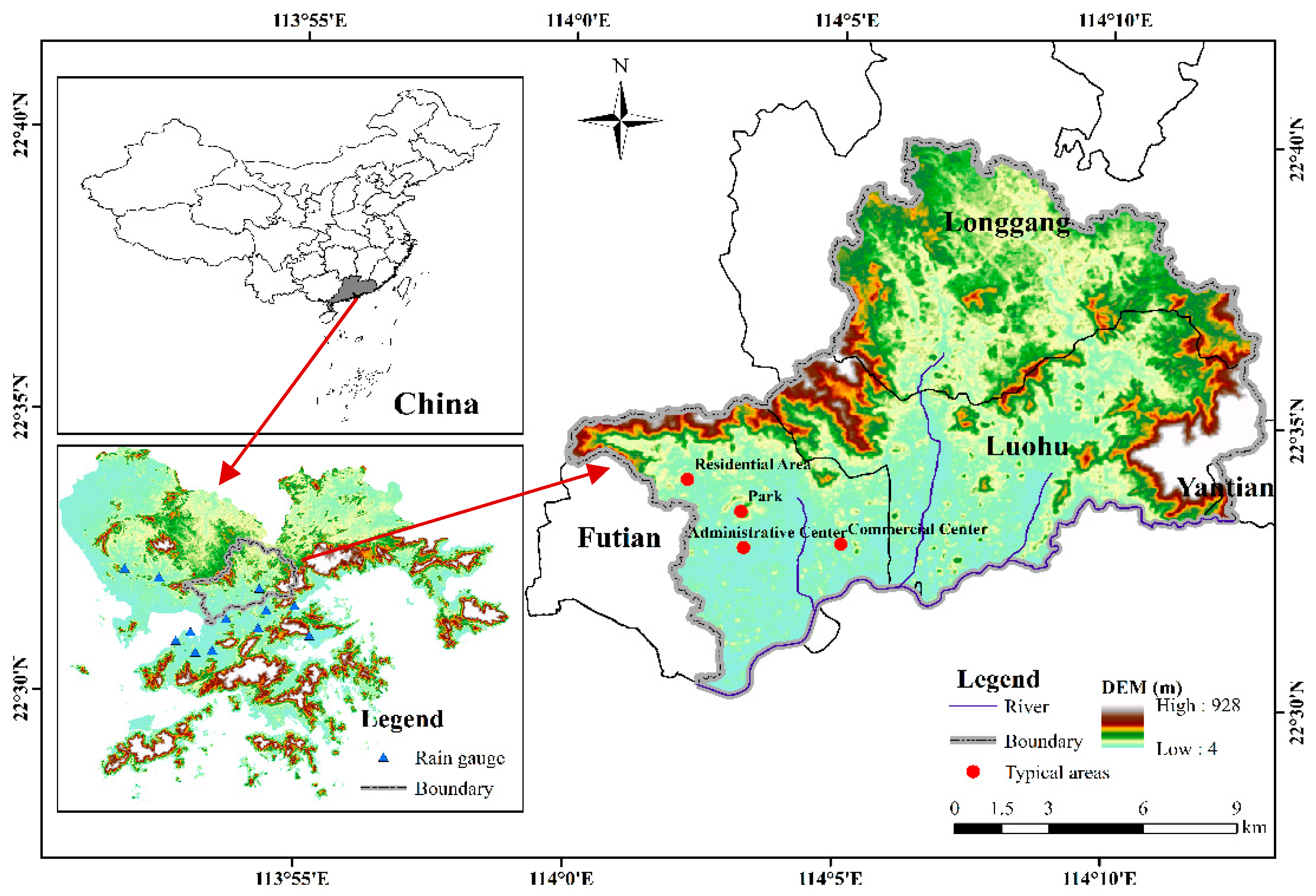
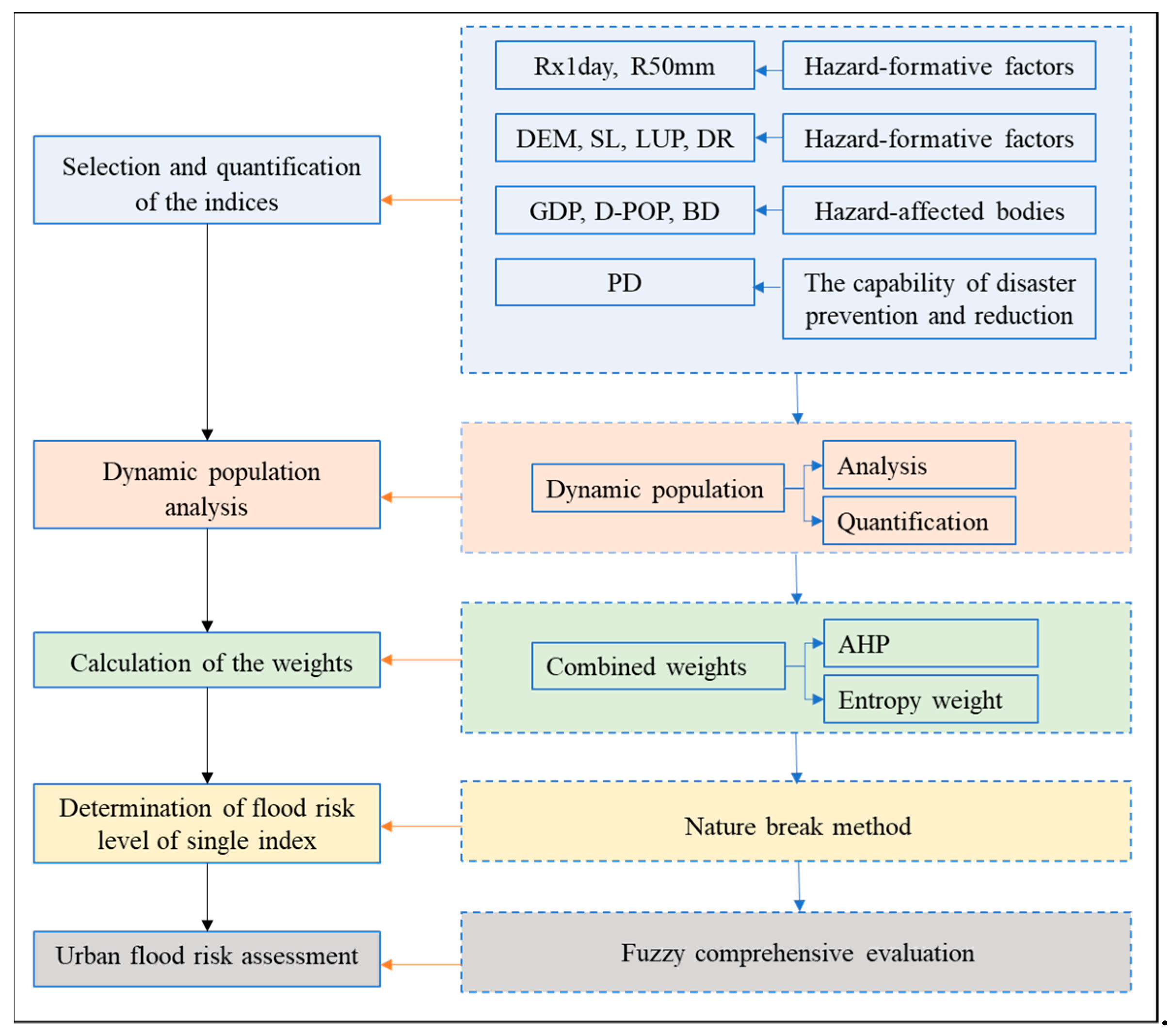


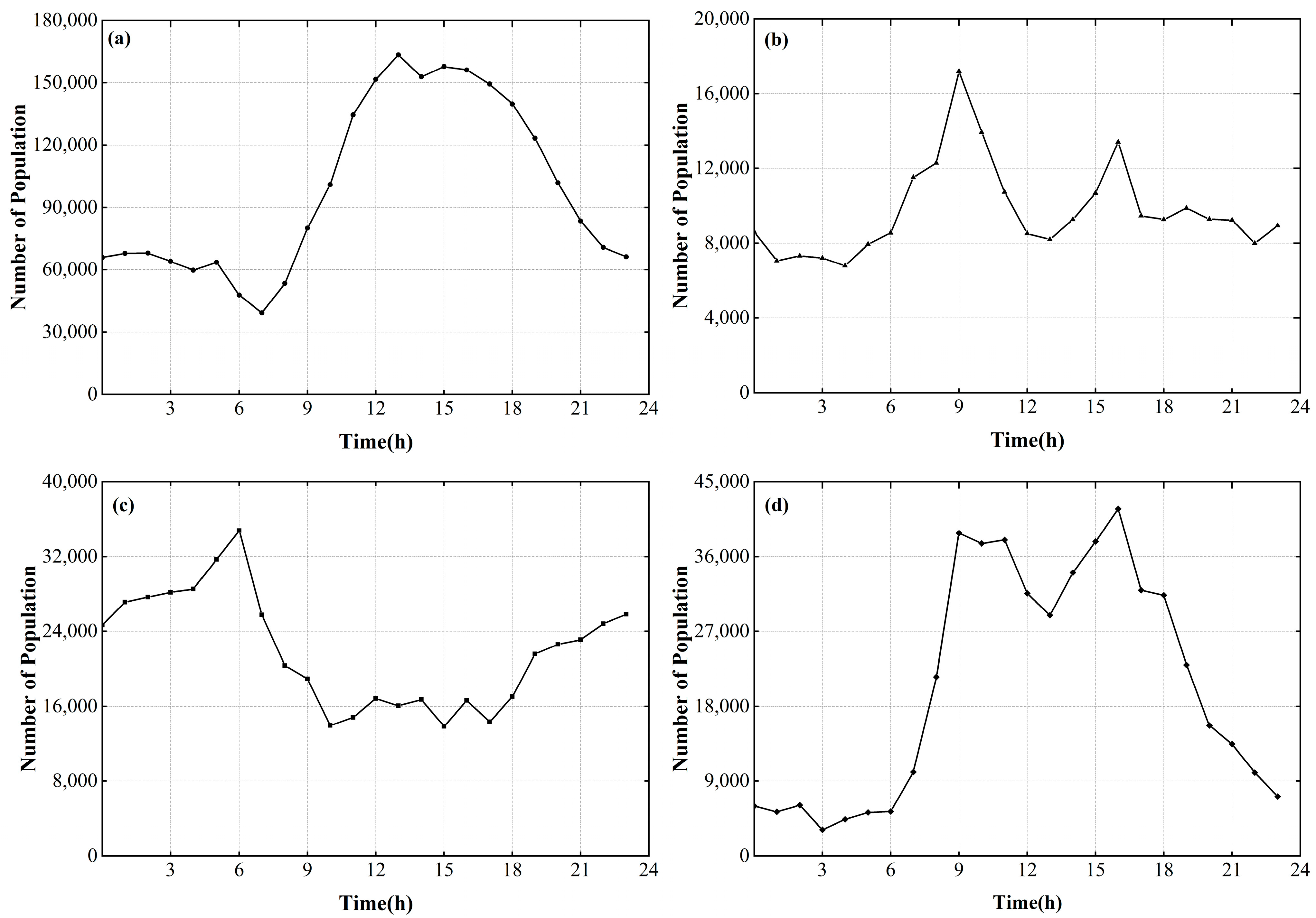
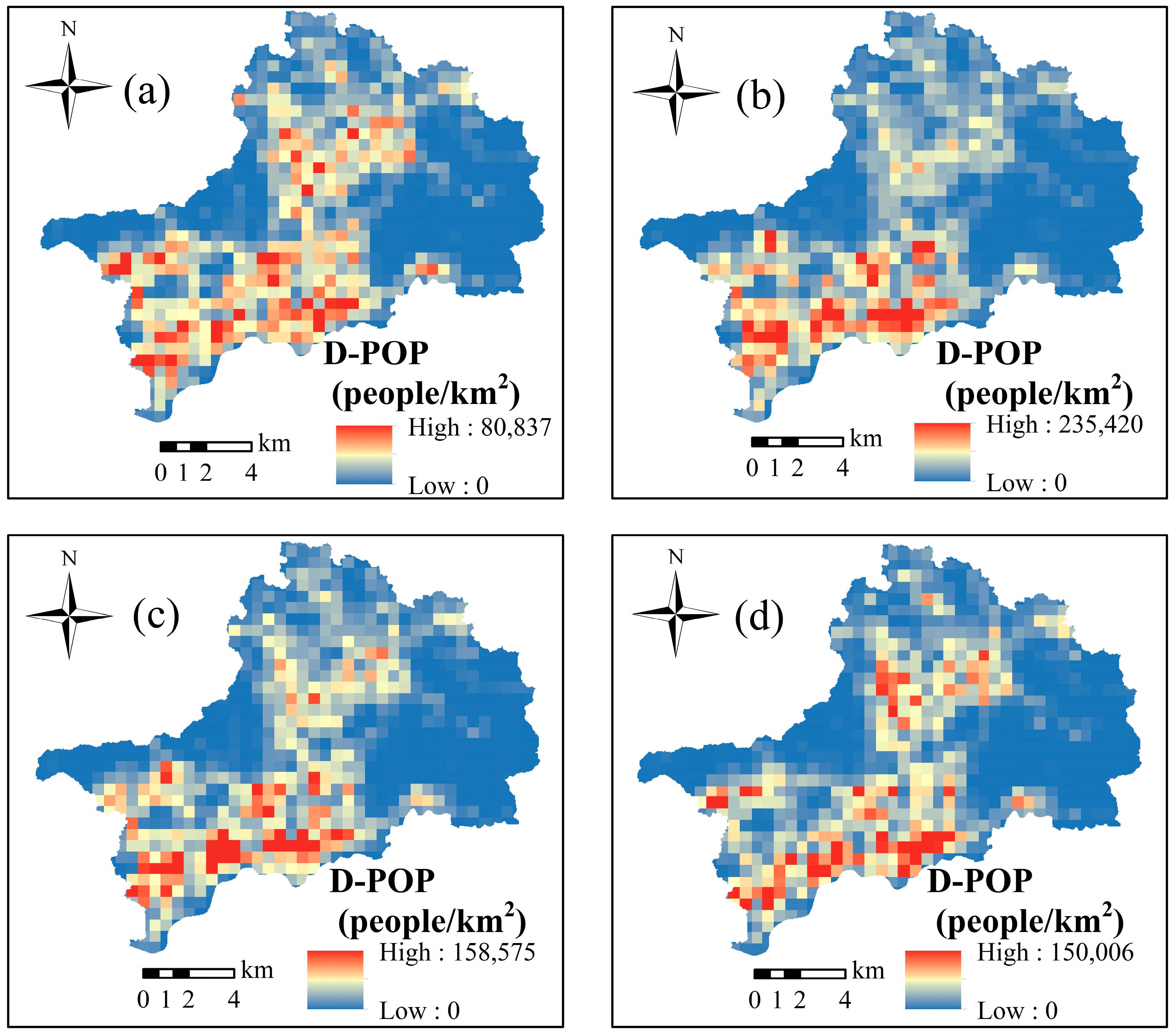
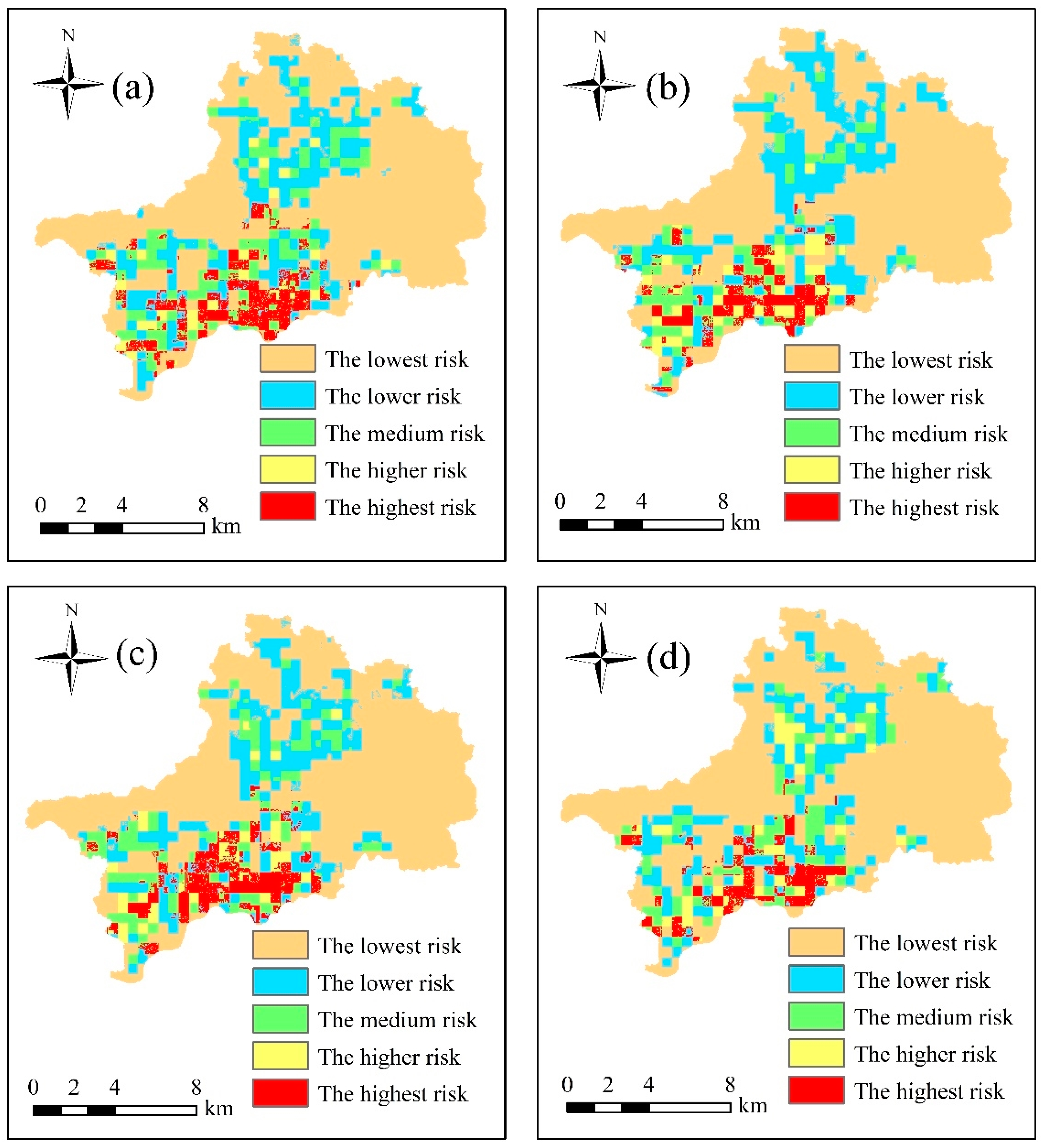
| Schemes | Criteria | Indices | Units | Attributes of Indices |
|---|---|---|---|---|
| Hazard | Hazard-formative factors | Rx1day | mm | + |
| R50mm | number/year | + | ||
| Hazard-formative environment | DEM | m | - | |
| SL | degree | - | ||
| LUP | / | + | ||
| DR | km | - | ||
| Vulnerability | Hazard-affected bodies | GDP | yuan/km2 | + |
| D-POP | people/km2 | + | ||
| BD | / | + | ||
| The capability of disaster prevention and reduction | PD | km/km2 | - |
| Indices | Rx1day | R50mm | DEM | SL | LUP | DR | GDP | D-POP | BD | PD |
|---|---|---|---|---|---|---|---|---|---|---|
| Rx1day | 1 | 4 | 5 | 7 | 6 | 5 | 3 | 2 | 7 | 2 |
| R50mm | 1 | 2 | 4 | 3 | 2 | 1/2 | 1/3 | 4 | 1/3 | |
| DEM | 1 | 3 | 2 | 1 | 1/3 | 1/4 | 3 | 1/4 | ||
| SL | 1 | 1/2 | 1/3 | 0.2 | 1/6 | 1 | 1/6 | |||
| LUP | 1 | 1/2 | 1/4 | 1/5 | 2 | 1/5 | ||||
| DR | 1 | 1/3 | 1/4 | 3 | 1/4 | |||||
| GDP | 1 | 1/2 | 5 | 1/2 | ||||||
| D-POP | 1 | 6 | 1 | |||||||
| BD | 1 | 1/6 | ||||||||
| PD | 1 |
| Indices | Methods | ||||||||
|---|---|---|---|---|---|---|---|---|---|
| AHP | EW | Combined Weights | |||||||
| TS1 | TS2 | TS3 | TS4 | TS1 | TS2 | TS3 | TS4 | ||
| Rx1day | 0.2596 | 0.0292 | 0.0286 | 0.0286 | 0.0283 | 0.0855 | 0.0816 | 0.0821 | 0.0801 |
| R50mm | 0.0808 | 0.0223 | 0.0217 | 0.0218 | 0.0215 | 0.0203 | 0.0193 | 0.0194 | 0.0190 |
| DEM | 0.0533 | 0.0033 | 0.0032 | 0.0032 | 0.0032 | 0.0020 | 0.0019 | 0.0019 | 0.0018 |
| SL | 0.0237 | 0.0066 | 0.0065 | 0.0065 | 0.0064 | 0.0018 | 0.0017 | 0.0017 | 0.0017 |
| LUP | 0.0352 | 0.2584 | 0.2523 | 0.2530 | 0.2499 | 0.1023 | 0.0977 | 0.0982 | 0.0959 |
| DR | 0.0533 | 0.0295 | 0.0288 | 0.0288 | 0.0285 | 0.0177 | 0.0169 | 0.0170 | 0.0166 |
| GDP | 0.1189 | 0.1591 | 0.1554 | 0.1558 | 0.1539 | 0.2129 | 0.2033 | 0.2044 | 0.1996 |
| D-POP | 0.1759 | 0.2432 | 0.2609 | 0.2588 | 0.2680 | 0.4816 | 0.5051 | 0.5024 | 0.5141 |
| BD | 0.0237 | 0.2428 | 0.2371 | 0.2378 | 0.2349 | 0.0648 | 0.0619 | 0.0622 | 0.0607 |
| PD | 0.1759 | 0.0057 | 0.0055 | 0.0056 | 0.0055 | 0.0112 | 0.0107 | 0.0108 | 0.0105 |
| Indices | Range of Indices | |||||
|---|---|---|---|---|---|---|
| Rx1day | 140.46 | 150.31 | 158.63 | 166.71 | 176.05 | 124.06–188.41 |
| R50mm | 5.92 | 7.04 | 7.97 | 8.84 | 9.65 | 4.09–10.56 |
| DEM | 522.00 | 335.00 | 196.00 | 105.00 | 48.00 | 4–928 |
| SLOP | 34.00 | 26.00 | 19.00 | 12.00 | 5.00 | 0–60 |
| LUP | 0.20 | 0.50 | 0.60 | 0.70 | 0.90 | 0.15–1 |
| DR | 5.99 | 4.60 | 3.32 | 2.09 | 0.97 | 0–8.21 |
| GDP | 83,665.00 | 182,638.00 | 267,973.00 | 404,129.00 | 680,763.00 | 38,844–962,809 |
| POP | 7385.71 | 20,310.71 | 36,005.34 | 58,162.48 | 110,785.67 | 0–235,420 |
| BD | 0.07 | 0.18 | 0.30 | 0.44 | 0.64 | 0–1 |
| PD | 7.52 | 5.41 | 3.81 | 2.30 | 0.71 | 0–11.99 |
| Sessions | Risk Levels | ||||
|---|---|---|---|---|---|
| Lowest Risk | Lower Risk | Medium Risk | Higher Risk | Highest Risk | |
| TS1 | 58.32 | 19.47 | 12.00 | 3.17 | 7.03 |
| TS2 | 59.32 | 21.28 | 8.88 | 4.54 | 5.99 |
| TS3 | 59.61 | 18.88 | 10.66 | 3.78 | 7.07 |
| TS4 | 62.97 | 17.16 | 10.00 | 4.64 | 5.22 |
Publisher’s Note: MDPI stays neutral with regard to jurisdictional claims in published maps and institutional affiliations. |
© 2022 by the authors. Licensee MDPI, Basel, Switzerland. This article is an open access article distributed under the terms and conditions of the Creative Commons Attribution (CC BY) license (https://creativecommons.org/licenses/by/4.0/).
Share and Cite
Chen, H.; Xu, Z.; Liu, Y.; Huang, Y.; Yang, F. Urban Flood Risk Assessment Based on Dynamic Population Distribution and Fuzzy Comprehensive Evaluation. Int. J. Environ. Res. Public Health 2022, 19, 16406. https://doi.org/10.3390/ijerph192416406
Chen H, Xu Z, Liu Y, Huang Y, Yang F. Urban Flood Risk Assessment Based on Dynamic Population Distribution and Fuzzy Comprehensive Evaluation. International Journal of Environmental Research and Public Health. 2022; 19(24):16406. https://doi.org/10.3390/ijerph192416406
Chicago/Turabian StyleChen, Hao, Zongxue Xu, Yang Liu, Yixuan Huang, and Fang Yang. 2022. "Urban Flood Risk Assessment Based on Dynamic Population Distribution and Fuzzy Comprehensive Evaluation" International Journal of Environmental Research and Public Health 19, no. 24: 16406. https://doi.org/10.3390/ijerph192416406
APA StyleChen, H., Xu, Z., Liu, Y., Huang, Y., & Yang, F. (2022). Urban Flood Risk Assessment Based on Dynamic Population Distribution and Fuzzy Comprehensive Evaluation. International Journal of Environmental Research and Public Health, 19(24), 16406. https://doi.org/10.3390/ijerph192416406






